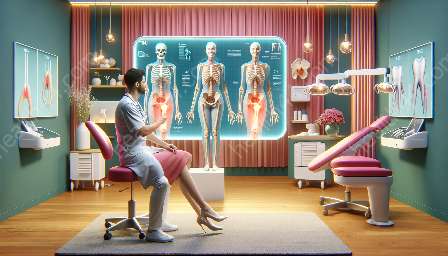The temporomandibular joint (TMJ) is a complex joint responsible for the movement of the jaw. Understanding the biomechanics of this joint is essential for comprehending the causes and management of TMJ disorders. In this comprehensive guide, we'll delve into the intricacies of the biomechanics of the temporomandibular joint and its link to TMJ disorders.
Biomechanics of the Temporomandibular Joint
The temporomandibular joint, or TMJ, is a pivotal joint that facilitates the movement of the lower jaw and plays a crucial role in various oral functions, including chewing, speech, and facial expression. It is a unique joint in the human body due to its dual function as both a hinge and a sliding joint.
One of the remarkable aspects of the TMJ is its ability to move in multiple directions, including rotation, translation, and gliding movements. These complex movements are made possible by the arrangement of the joint's components, including the articular disc, which allows smooth articulation between the temporal bone and the mandible.
The biomechanics of the temporomandibular joint are influenced by a network of muscles, ligaments, and the overall structure of the joint itself. The coordinated action of these components ensures proper jaw movement, stability, and function. Additionally, the TMJ is subjected to dynamic loading during various activities such as chewing, speaking, and swallowing, making its biomechanics crucial for optimal oral health.
Causes of Temporomandibular Joint Disorders
Despite the unique and intricate design of the TMJ, it is susceptible to a range of disorders, collectively known as temporomandibular joint disorders (TMD). These disorders can manifest as pain, restricted jaw movement, clicking or popping sounds, and associated symptoms affecting the head, neck, and facial regions.
The causes of temporomandibular joint disorders are multifactorial and can be attributed to various factors, including anatomical, physiological, and psychological aspects. Some common causes of TMJ disorders include:
- Dysfunction in the alignment or movement of the joint components
- Bruxism (clenching or grinding of teeth)
- Trauma or injury to the jaw
- Arthritic conditions affecting the TMJ
- Muscle tension and imbalance
- Malocclusion (incorrect bite)
- Poor posture and stress
Understanding the biomechanics of the temporomandibular joint is essential for identifying how these causes can lead to TMD. For instance, malocclusion can create imbalanced forces on the TMJ during jaw movement, leading to increased wear and tear on the joint components. Similarly, chronic muscle tension and bruxism can disrupt the harmonious biomechanics of the TMJ, resulting in pain and dysfunction.
Temporomandibular Joint Disorder (TMJ): Complexity and Management
Temporomandibular joint disorder (TMJ) encompasses a spectrum of conditions that affect the TMJ and surrounding structures, presenting a complex challenge for patients and healthcare professionals. The multifaceted nature of TMJ disorders requires a comprehensive understanding of its biomechanics and contributing factors for effective management.
The management of TMJ disorders involves a multidisciplinary approach, often including dentists, oral and maxillofacial surgeons, physical therapists, and other healthcare specialists. Given the diverse causes and manifestations of TMD, a personalized treatment plan is essential to address the biomechanical and physiological aspects specific to each patient.
Therapeutic strategies for TMJ disorders may include:
- Orthodontic treatment to correct malocclusion and alignment issues
- Physical therapy and exercise regimens to improve jaw mobility and muscle function
- Stress management techniques and behavioral therapies to reduce bruxism and muscle tension
- Orthopedic interventions to support the biomechanics of the TMJ
- Pharmacological interventions for pain management and inflammation
- In severe cases, surgical interventions may be considered for structural or functional restoration of the TMJ
The comprehensive management of TMJ disorders also involves patient education and self-care practices. Patients can benefit from understanding the biomechanics of the temporomandibular joint and how various lifestyle factors and habits can influence its function. For instance, maintaining good posture, practicing relaxation techniques, and following oral hygiene practices can contribute to the long-term well-being of the TMJ.
In conclusion, the biomechanics of the temporomandibular joint are integral to the understanding and management of TMJ disorders. By exploring the intricate movements and structures involved in TMJ function, healthcare professionals can devise tailored approaches to address the complexity of TMJ disorders, ultimately improving the quality of life for individuals affected by TMD.


